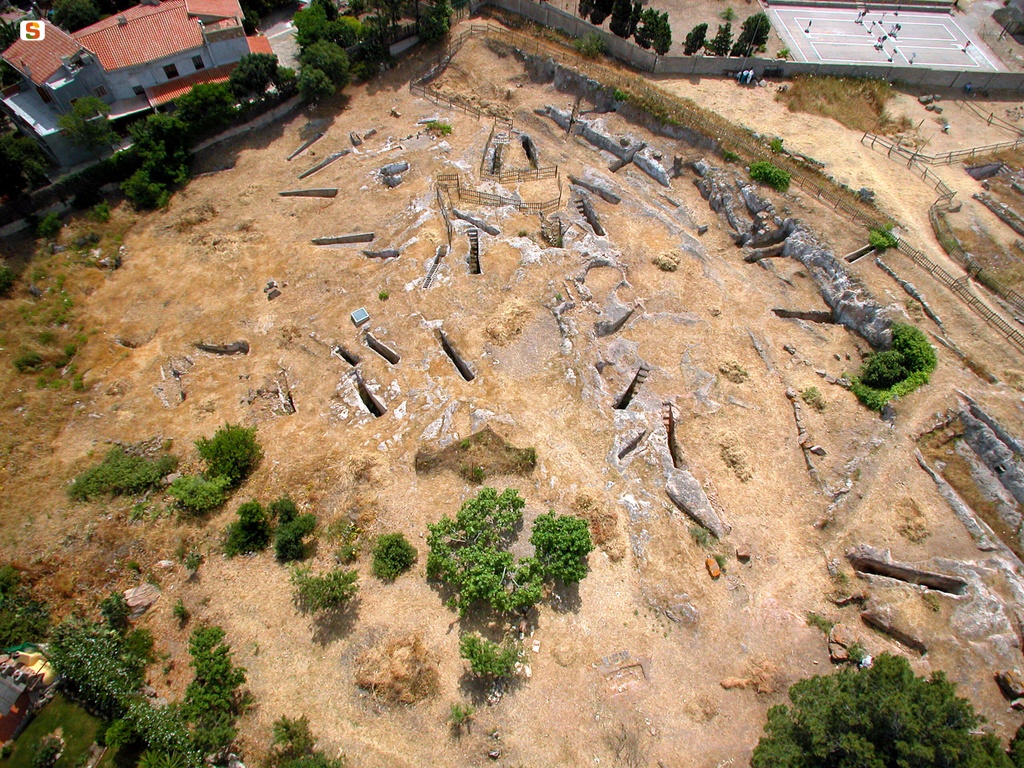Tharros is located at the southern end of the Sinis Peninsula. It unfolds in the Gulf of Oristano on a sort of natural amphitheater delimited to the north by the hill of Su Muru Mannu, to the west by that of the tower of San Giovanni and to the south by the isthmus that connects the latter to the promontory of Capo S. Marco.
The urban center of Tharros has developed on the Sinis Peninsula, a territory favorable to human settlement due to the ease of landing, the fishness of the water and the fertility of the soil. The birth of the Phoenician city of Tharros dates back to the final decades of the 7th century BC. The presence of objects from outside the island, Oriental, Etruscan and Greek both in the tombs and in the hinterland, together with data from the necropolises and some emergencies, offer us the image of a center of significant importance. The massive urban planning interventions in the Roman era have erased many traces of previous civilizations.
The Punic Age, on the other hand, offers good documentation. The studies reveal a hierarchical territorial organization in which the major settlement acted as a collecting center for the agro-pastoral resources of the territory, which was maintained in use even during the Roman Republican period, until the radical transformation of the structure of the countryside in the Imperial Age.
Most of the Punic settlements are small in size. The Phoenician-Punic city is characterized by the presence of two necropolises, arranged respectively to the north and south of the town. The northern necropolis is located about one kilometer north of the Su Muru Mannu hill. Phoenician cremated grave tombs have been unearthed, dating between the end of the 7th and 6th centuries BC. The southern necropolis was the largest, consisting of dozens and dozens of very rich tombs, so much so that it triggered a real hunt for gold treasure in the 19th century, following which many burial kits merged into private and public collections, Italian and foreign. The type of objects coming from the necropolises gives us the picture of a rather rich city at the crossroads of the commercial routes of the western Mediterranean: gold and silver jewelry, ceramics from Greece, Egyptian-type amulets, scarab-shaped seals worked locally.
The tofet is of particular importance: a typical necropolis of Phoenician and Punic cities in the West, intended for the burial of the ashes of children born dead or deceased shortly after birth. In the Phoenician Age, urns containing ashes were placed in the bare ground, sometimes collected in small enclosures of slabs or stones, but without elevated structures. In the Punic period, from the end of the 6th century BC onwards, stone steles carved with symbols or images of deities began to be placed. The Tharros tofet is located on the top of the Su Muru Mannu hill, exploiting the remains of the huts of a previous Nuragic village.
Undoubtedly, the so-called 'temple of the semicolumns' is also significant evidence of Tharros punica. Located in the central public area of the city, the temple was carved from living rock “by way of lifting”, that is, carving the stone to form a rectangular terraced podium, whose long sides and the short rear side are adorned with semicolumns sculpted with the same technique.
History of excavations
The investigations of the site began in 1838 by the Marquis Scotti and the Jesuit Perotti. In 1842, an excavation commissioned by the King of Sardinia Carlo Alberto enriched the royal collections of Turin with gold coins, jewels and scarabs. Thanks to the king, the prohibition of clandestine excavations aimed at illegal enrichment was obtained. In 1851, Lord Vernon, an Englishman who was on the 'Grand Tour' of Italy, dug 14 tombs in the underground chamber and, among other things, found many jewels, which he took with him to England. The discoveries aroused the interest of the inhabitants of nearby Cabras, who violated about 500 tombs. In 1860, the then director of the Cagliari museum, Gaetano Cara, discovered some Punic tombs containing rich items, which he stole and offered to the main museums in Europe, eventually selling them to the British Museum in London. From 1956 to 1964, Gennaro Pesce brought to light part of the town to the east of the tower of S. Giovanni and, to the north, the area of the tofet. Ferruccio Barreca, in 1958, identified the small temple at the end of Capo San Marco and, from 1969 to 1973, he continued the excavations of the town, the fortifications and the tophet. This last area was investigated in collaboration with Enrico Acquaro.
Bibliography
G. Pesce, Tharro “, in “Encyclopedia of Ancient, Classical and Oriental Art”, VI, Rome 1966, pp. 800-806;
E. Acquaro - C. Finzi, Tharros, series “Archaeological Sardinia. Guides and itineraries”, 5, Carlo Delfino, Sassari, 1986;
R.D. Barnett - C. Mendleson, Tharros. A Catalogue of Material in the British Museum from Phoenician and Other Tombs at Tharros, Sardinia, British Museum, London 1987;
M. Falchi, Analysis of the urban configuration of Tharros, in “Tharros”, edited by P. Desogus, Nuoro, 1991, pp. 23-37;
R. Zucca, Tharros, Oristano, G. Corrias, 1993; E. Acquaro, C. Finzi, Tharros, series “Archaeological Sardinia. Guides and itineraries”, 5, Sassari, Carlo Delfino, 1999;
C. Del Vais, The Third Life of Tharros the Plundered City, “Darwin. Notebooks”, n. 1 (July-August 2006), pp. 76-85.
Content type:
Archaeological complex
Archaeology
Province: Oristano
Common: Cabras
Macro Territorial Area: Central Sardinia
POSTAL CODE: 09072
Address: SP 6 - località Tharros, San Giovanni di Sinis
Website: www.tharros.sardegna.it/info-e-prenotazioni/orari-e-modalita-di-visita-di-tharros
Update
Where is it
Images


Author : cultura punico-romana
Results 2 of 113895
View AllVideo
Comments